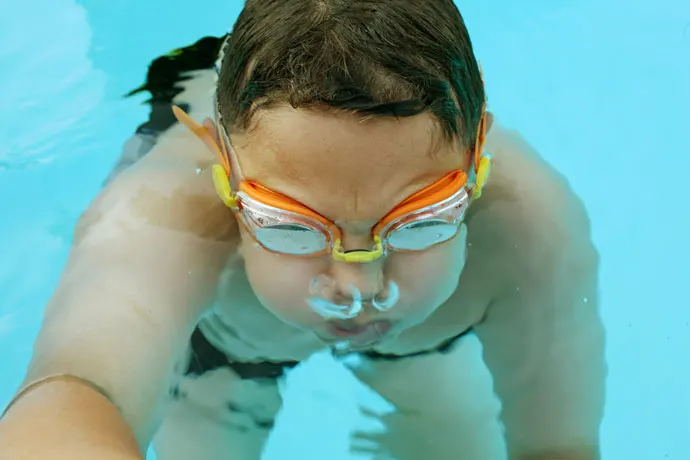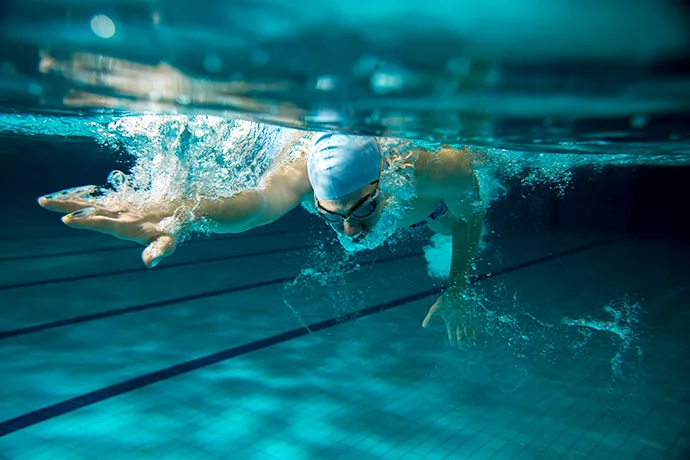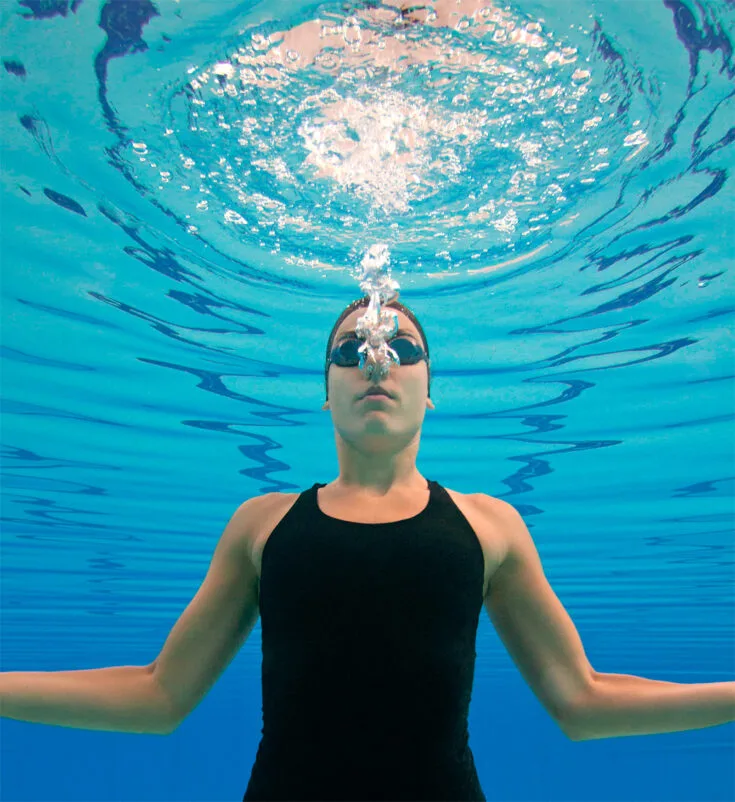This article discusses a few basic tips and exercises that you can use to become familiar with the breathing technique used while swimming.
This is important because controlling your breath is one of the big challenges that you have to overcome when you start swimming.
Once you have good breathing control and have also learned to float easily, incorporating breathing into your swimming becomes more straightforward.

Basic Breathing Tips
To help you get started, here are some general tips on breathing while swimming:
1) Wear swimming goggles. Without goggles, water can get into the eyes and irritate them. Water in the eyes can also restrict your vision, which can lead to anxiety.
You can minimize these problems by wearing swimming goggles. As a result, you will be more relaxed and can better focus on your breathing.
2) There are several swimming strokes where the head is submerged during the stroke cycle. But, you should not hold your breath while the head is underwater.

Instead, you should exhale continuously in water. If you do this correctly, your lungs should be almost empty when the head breaks through the water surface to take the next breath.
3) You should breathe in quickly as soon as your mouth is above the water surface. This should be easy to do if you have previously emptied your lungs in the water.
Basic Breathing Exercises
The following basic exercises can be used to become familiar with the breathing technique in the water. Wear swimming goggles when performing those exercises.
Exercise #1: Go into the shallow water. Crouch down until your head is underwater. Stay in this position for a few seconds and then stand up.
Exercise #2: This exercise is similar to exercise #1, except that you blow bubbles through your nose when your head is underwater.

Exercise #3: This exercise is similar to exercise #2, but now you blow bubbles through both your nose and mouth.
Exercise #4: Crouch down in shallow water until the water surface is located between your nose and mouth.
Now, practice breathing in through your nose above water and breathing out through your mouth underwater.
Exercise #5: Crouch down in shallow water until your face is submerged. Start to blow bubbles.
Grab the edge of the pool and continue to blow bubbles while getting into a horizontal position with the face down.
To get into a horizontal position, you can use a relaxed flutter kick.
Exercise #6: Bob up and down in shallow water so that your head dips into the water and pops up again.
Breathe in when your head is above water and breathe out when your head is underwater.
This exercise introduces you to rhythmic breathing, a technique that you will have to use while swimming.
Conclusion
This concludes our article on basic tips and exercises for learning the breathing technique in swimming. I hope this information will be helpful to you.

Adam
Sunday 26th of July 2020
This page is very helpful. I am a senior adult teaching myself to swim. Although I get around treading water OK, I have great trepidation about putting my face in the water. Your progressive baby steps outlined here seem practical and I intend to try them. Thank you.
Christophe
Sunday 26th of July 2020
Thanks for your nice comment, Adam! And lots of success in the water!
Rick Lecluse
Sunday 27th of October 2019
I am 56 years old trying to relearn swimming. As a child I was very good at swimming. A near drowning incident left me not swimming for over 40 years.
Today, when I was at the local pool, I noticed that whenever I tried to exhale underwater, mouth or nose, very high anxiety kicked in.
I want to beat this. Any suggestions?
Christophe
Monday 28th of October 2019
Hi Rick,
It's nice that you want to get into swimming again. Did you see the following article about overcoming the fear of water:
https://www.enjoy-swimming.com/overcoming-fear-of-water-1.html
Sara
Thursday 8th of August 2019
Hi!
I recently started taking swimming sessions. Today was my third.
I don’t have any problem when I float on my stomach. I inhale through nose and exhale under water by making bubbles.
When I float I can’t hold my breath for long and I start changing my posture in order to inhale above water. I started drowning twice. The only problem is my breathing.
Today once I hold my breath and I swam till the pole by moving my legs. But when I tried again I was having same breathing issue. Might be because I had this issue few years before. Breathing problem due to my cat's hair.
Now I’m fine but don’t know when I am supposed to inhale and am I breathing properly or not. I start feeling suffocated so I’m unable to swim properly.
Sans
Friday 5th of April 2019
I'm 16 and today I started going to my swimming class. I can't exhale smoothly underwater...
My sir said I have to exhale in one breath. But I can only exhale slowly. In small amounts underwater...
What should I do? Is it my health problem? And are fat boys like me able to float above water?
Christophe
Sunday 14th of April 2019
Hi Sans,
Given that this was your first swimming class, I think you just need a little patience.
At this point, I would follow the instructions of your swim instructor, and it is very likely that with a little time, things will work out for themselves.
Good luck!
Sujata Anand
Monday 21st of January 2019
Forgot to mention my first reaction!! This site is so wonderful and helpful!! It indeed is! Thanks a ton for this!! :-) :-)
Christophe
Tuesday 22nd of January 2019
Thanks a lot Sujata!